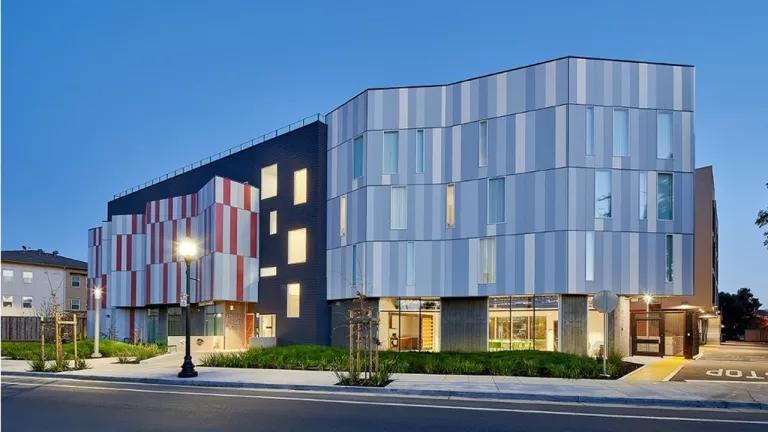No More Climate Money for Fossil-Fueled Affordable Housing
It is time to end public investment in new buildings that burn fossil fuels for heating and cooking, locking residents into decades of pollution and undermining California’s climate progress.

MidPen's first all-electric affordable housing project with David Baker Architects: Edwina Benner Plaza in Sunnyvale, California.
This blog was co-authored by Andrew Brooks (Association for Energy Affordability)
It is time to end public investment in new buildings that burn fossil fuels for heating and cooking, locking residents into decades of pollution and undermining California’s climate progress. Next week, the Strategic Growth Council will have the opportunity to end the practice of spending cap-and-trade funds to subsidize new fossil-fueled low-income housing and instead focus funding on all-electric affordable housing powered with renewable energy—but will it?
The Council administers the Affordable Housing and Sustainable Communities (AHSC) program to support new low-income housing developments with funds from California’s Greenhouse Gas Reduction Fund (GGRF). The AHSC program has granted over $1 billion in funding to date. At its Nov. 17 meeting, the Council will consider updating guidelines for the program. Unfortunately, the current draft guidelines only award two points to projects that are all-electric, of 100 possible points used to select winning projects, which is not enough to make a difference. The Council should increase the points for all-electric buildings this year to ten points and—most importantly—make a clear public commitment to only consider all-electric buildings for funding in the next annual cycle.
Climate dollars must support the state’s climate commitments
As members of the environmental community pointed out in a recent letter, the purpose of the GGRF (which uses proceeds from the state’s cap-and-trade program) is to “facilitate comprehensive and coordinated investments throughout California that further the State’s climate goals.” However, the AHSC program continues to fund new affordable housing that runs on natural gas (a.k.a. fossil gas), which contradicts the urgent need to protect community and environmental health by weaning the state off fossil fuels.
Buildings that use efficient electric space heating, water heating, and cooking technologies emit zero pollution on-site. And when powered by electricity generated from emissions-free renewable resources like wind and solar, these technologies enable buildings to run on 100-percent clean energy.
The California Energy Commission (CEC) concluded in its 2018 Integrated Energy Policy Report that “[t]here is a growing consensus that building electrification is the most viable and predictable path to zero-emissions buildings” and is “essential to California’s strategy to meet its [greenhouse gas] reduction goals for 2030 and 2050.” A recent California Air Resources Board report similarly found that “[a]chieving carbon neutrality by 2045 requires ambitious near-term actions around deployment of…building electrification,” which is a least-regrets strategy across all policy-compliant scenarios.
Affordable housing must support community and resident health
Core priorities of the AHSC program are “reducing air pollution, improving conditions in disadvantaged communities,” and “supporting or improving public health.” But funding gas-reliant homes undercuts these objectives.
Appliances in buildings burn more gas than all the state’s power plants, and create significantly more nitrogen oxide (NOx) emissions. NOx is a precursor to ozone and particulate matter, which are key pollutants to curb in order to comply with state and federal air quality standards. All-electric buildings reduce NOx and ground-level ozone, improving air quality and benefiting public health. A recent study from the UCLA Fielding School of Public Health found that immediate replacement of all residential gas appliances in California with clean electric alternatives would result in 354 fewer deaths, 596 fewer cases of acute bronchitis, and 304 fewer cases of chronic bronchitis annually due to improvements in outdoor air quality alone—the monetized equivalent of $3.5 billion in health benefits per year.

All-electric affordable housing is achievable—and support is available for the transition
Low-income housing really can make the transition to all-electric, and in fact this is already happening. But we need clear policy to push the affordable housing community across the line to have all-electric become standard practice.
Many affordable housing developers have completed all-electric projects and have more in the pipeline, while many others are considering all-electric construction as momentum builds. For example, the Fresno Housing Authority, motivated by local air quality concerns, has been developing all-electric buildings since 2015 and has nine projects either built or in the pipeline.
Wakeland Housing and Development Corporation—with projects in San Diego, Los Angeles and Riverside counties—has one new development under construction and has completed one all-electric retrofit of an existing building. The company intends to have most of its future projects be all-electric due to environmental concerns. Wakeland also values the time and money saved in only connecting one energy service.
During a recent listening session with four California-based affordable housing developers, participants acknowledged that they see the market moving toward all-electric construction, but said their peers needed support in the transition.
Fortunately, help is on the way. The CEC will launch the BUILD program (SB 1477) in 2021. This will provide $60 million in direct incentives for new low-income housing that is built all-electric. The program will also be providing robust technical assistance to affordable housing developers to support their projects.
The support of the BUILD program, along with a clear signal from the Council to AHSC applicants, is the combination needed to transform the market for affordable housing. We urge the Strategic Growth Council to award more points for all-electric buildings in this funding cycle, and to make a public commitment to only consider all-electric buildings for funding in the next annual cycle.



